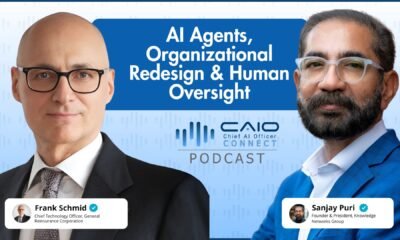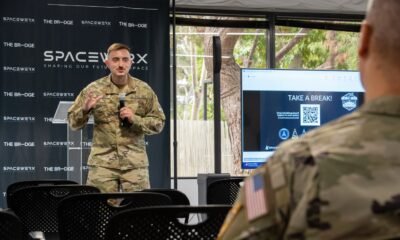Education
Duolingo Embraces AI in Push for Scalable Learning — Campus Technology
Duolingo Embraces AI in Push for Scalable Learning
In 2012, Duolingo co-founder Luis von Ahn defied the prevailing wisdom of building desktop-first experiences and pushed his nascent language learning startup onto mobile. A year later, Duolingo was Apple’s iPhone App of the Year. Fast forward to 2025, and von Ahn is making another bet. This time, it’s on artificial intelligence — and it’s potentially even more transformative.
“We’re making a similar call now, and this time the platform shift is AI,” von Ahn wrote in a company-wide memo posted publicly on LinkedIn. “AI is already changing how work gets done. The worst thing you can do is wait.”
Duolingo, the Pittsburgh-based company behind the chirpy green owl and more than 500 million users, has officially declared itself “AI-first.” But beneath that buzzy label lies a seismic restructuring — one that shifts roles, reshapes how hiring and performance are evaluated, and redefines the relationship between people and technology at Duolingo.
From Mobile-First to AI-First: A Cultural Reset
“AI-first” at Duolingo doesn’t just mean sprinkling generative tech over existing workflows. It means dismantling them. The memo outlines sweeping changes: phasing out contractors in favor of AI tools, evaluating employee performance based on AI adoption, and restricting headcount growth unless teams can prove that automation isn’t an option.
In the hands of a less charismatic founder, this might read like a Silicon Valley bloodletting. But von Ahn frames it as a kind of creative liberation.
“This isn’t about replacing Duos with AI,” he insisted. “It’s about removing bottlenecks so we can do more with the outstanding Duos we already have.”
That framing doesn’t obscure the stakes. Duolingo will “gradually stop using contractors to do work that AI can handle,” echoing a similar move last year when the company cut about 10% of its contract workforce after integrating AI into its translation pipeline. Now, AI will be enlisted to help with everything from content creation to hiring decisions to performance evaluations.
Scaling Learning, One AI at a Time
The rationale? Scaling. The same way mobile helped Duolingo go viral, von Ahn believes AI can democratize quality education at a planetary scale. “To teach well, we need to create a massive amount of content,” he wrote. “Doing that manually doesn’t scale.”
AI, he argued, is the only realistic path forward. It’s already being used to power features like Video Call, where users interact with AI-powered tutors like the deadpan, goth-inspired Lily. And Duolingo’s content production — once a slow, editorial slog — is now increasingly generated by machine learning pipelines.
This isn’t just about speeding things up. Von Ahn sees AI as a path toward pedagogical parity with human tutors — replicable, scalable, and always available.
Constraints as a Catalyst
To get there, von Ahn said, Duolingo must embrace “constructive constraints.” Performance reviews will now include metrics for AI utilization. Hiring? Only if automation fails. Functions across the company are being asked to rebuild from the ground up.
“Making minor tweaks to systems designed for humans won’t get us there,” the memo reads. “In many cases, we’ll need to start from scratch.”
It’s an echo of Shopify CEO Tobias Lütke’s recent directive that employees justify new hires by proving AI couldn’t do the job. It’s also a signal that a new corporate orthodoxy is emerging — one where AI fluency is table stakes for survival.
The Uneasy Trade-Off
Of course, that new orthodoxy has its critics. On social media, some users lambasted Duolingo’s shift as a betrayal of its quirky, accessible brand. Others, perhaps more resigned, suggested this was inevitable.
“When a CEO says they want more AI, it means they want more money in their bank account,” one X user quipped.
There’s also the question of efficacy. In a working paper released earlier this month (“Large Language Models, Small Labor Market Effects,”) economists Anders Humlum and Emilie Vestergaard looked at the labor market impact of AI chatbots on 11 occupations, covering 25,000 workers and 7,000 workplaces in Denmark in 2023 and 2024. The researchers found that AI tools reduced actual work hours by just 2.8% — far less than the industry hype suggests. Critics warn that Duolingo’s urgency could come at the cost of quality, nuance, and human insight.
Von Ahn seems unbothered. “We’d rather move with urgency and take occasional small hits on quality than move slowly and miss the moment,” he wrote.
A Mission Rewritten
For von Ahn, AI is not just a tool. It’s a mission accelerant. “AI helps us get closer to our mission,” he writes, referring to Duolingo’s goal of providing accessible education globally. “We owe it to our learners to get them this content ASAP.”
But for the contract workers whose jobs are being automated away, the urgency feels more like obsolescence. And for full-time employees, the future now includes being judged not just by managers — but by how well they wield the very AI that replaced their former colleagues.
About the Author
John K. Waters is the editor in chief of a number of Converge360.com sites, with a focus on high-end development, AI and future tech. He’s been writing about cutting-edge technologies and culture of Silicon Valley for more than two decades, and he’s written more than a dozen books. He also co-scripted the documentary film Silicon Valley: A 100 Year Renaissance, which aired on PBS. He can be reached at [email protected].
Education
The Guardian view on free nursery places: risks as well as rewards must be monitored | Editorial

With the change of season, ministers know they must get back on the front foot after weeks during which their opponents have made the political weather. The launch of a new, more generous regime for funding early years education in England should help. The first of September was keenly awaited by hundreds of thousands of working parents of children aged between nine months and four. As of now, they are entitled to 30 free childcare or nursery hours a week.
The education secretary, Bridget Phillipson, is right to stress that this is the biggest-ever expansion of early years provision – described by the Institute for Fiscal Studies as “a new branch of the welfare state”. Equivalent to about £7,500 per year, per child, this is worth more, to most women in full-time work, than abolishing their income tax and national insurance contributions. Working-age parents, particularly those with larger families, have been dealt with less generously by the tax and benefits systems in recent years than under the Blair and Brown governments. The UK has higher childcare costs than most leading economies. So it is right that parents of the youngest children are targeted with support.
Implementation will need to be closely monitored, however. Most of the new funding will flow to private providers. Ms Phillipson is a strong advocate for new nurseries attached to primary schools, but these are small in number. Families are being given additional funding, but not a new public service. The new subsidy will not cover fees in full. Many nurseries face shortages of trained staff, while the number of childminders – usually women working at home – keeps on falling.
While there are many good private and non-profit nurseries, as well as public ones overseen by councils, there is cause for concern about the way that this market has developed. As in children’s social care and special needs education, private-equity owned businesses control a growing number of settings. Last year, academics published research showing that privately run care homes were disproportionately likely to be closed by regulators. In children’s social care, the Competition and Markets Authority judged that private owners were making excessive profits and carrying too much debt, leading to unacceptable risks.
Ministers must ensure that such shocking failures are not repeated in the nursery sector. As a first step, Ofsted inspections should increase from their current six-yearly cycle to a four-yearly one – the same as schools. The current disparity sends a terrible signal about early years’ lowly status.
Another issue is the impact of the changes on poorer children who do not meet the eligibility criteria because their parents do not work or do not meet the £9,518 earnings threshold. While some vulnerable families already qualify for additional childcare, experts are right to worry that the existing attainment gap could grow as a result of a policy that grants extra funding to under‑fives from wealthier homes.
This is the logical but troubling consequence of a policy whose chief aim is to enable parents to work, rather than invest in early years education as an intrinsic good. The hope must be that rules change if these fears are realised, and that “family hubs” – which the Tories brought in after vandalising Sure Start – make a contribution to these families’ welfare in the meanwhile. Ms Phillipson has a lot on her plate. Extra spending on early years is welcome – but it needs proper oversight.
Education
Badenoch urged to ‘come clean’ after doubt cast on Stanford University claim | Kemi Badenoch

Labour and the Liberal Democrats have called for Kemi Badenoch to come clean about her claims of an offer from Stanford University at the age of 16, after former admissions staff said she had described an impossible scenario.
The Labour MP Peter Prinsley has written to the Conservatives leader saying she should lay out the specifics of how the alleged offer came about, given the doubts cast over her story. The Lib Dem education spokesperson, Munira Wilson, said Badenoch risked undermining trust.
Badenoch has defended her claim to have received an offer as a teenager in Nigeria from the elite university to study medicine, sometimes described by her as pre-med, even though the university does not offer that course for undergraduates.
Admissions staff have also said the Conservative leader’s assertion she was offered a place on exam results alone, and was offered a partial scholarship, would not have been possible, with no offers made on that basis.
Jon Reider, the admissions officer during the period Badenoch applied, told the Guardian he had been responsible for international admissions and scholarships and had not offered one to Badenoch.
Badenoch doubled down on Monday, telling reporters she had indeed received offers based on her exam results. “All I will say is that I remember the very day those letters came to me. It was not just from Stanford. I was 16, I had done very well in my SATs,” she said. “But this is 30 years ago, I don’t have the papers, and what the Guardian is doing is reporting on hearsay rather than talking about what the government is doing.”
Multiple former admissions staff and US academics have told the Guardian that Stanford has never made offers based only on SATs – US standardised tests – with no exceptions even for royalty or child prodigies.
Prinsley, a former hospital consultant, wrote to Badenoch to say her claims have been “called into serious question by people in a position to understand the situation, and I would be grateful if you could demonstrate that you have been telling the truth”.
He said the Tory leader should clear up whether she had applied to Stanford and whether a place and financial aid had been offered.
A Labour source said: “Honesty and integrity aren’t optional qualities for those who serve as the leader of His Majesty’s official opposition. The uncertainty surrounding Kemi Badenoch’s Stanford University claims raises important questions that the public deserve to know the answers to.
after newsletter promotion
“Badenoch needs to come clean about what’s happened here and whether she’s been telling the truth to the British people.”
Wilson also wrote to Badenoch saying she should come clean. “If Kemi Badenoch cares about restoring trust, she should start by explaining her own academic record,” she said. “Failing to come clean over these allegations would send a message to the thousands of pupils who just received their exam results that their hard work does not matter and that you can just bluff your way to the top.”
Education
How Generative AI Is Completely Reshaping Education

Opinions expressed by Entrepreneur contributors are their own.
This is the second installment in the “1,000 Days of AI” series. As an AI keynote speaker and strategic advisor on AI university strategy, I’ve seen firsthand how generative AI is transforming education — and why aligning with the future of learning is now a leadership imperative.
I’m starting with education, not because it was the most disrupted, but because it was the first to show us what disruption actually looks like in real time.
Why start here?
Education is upstream to everything. Every future engineer, policymaker, manager and founder is shaped by what happens in a classroom, a lecture hall or a late-night interaction with a search engine. When generative AI arrived, education didn’t have the luxury to wait. It was forced to adapt on the fly.
ChatGPT didn’t quietly enter higher education. It detonated. Assignments unraveled. Grading frameworks collapsed. Students accessed polished answers in seconds. Faculty were blindsided. Institutional responses were reactive, inconsistent and exposed deep fractures in how learning was being defined and delivered.
The idea that education meant memorization and regurgitation cracked almost overnight.
Related: How AI Is Transforming Education Forever — and What It Means for the Next Generation of Thinkers
AI in education didn’t break higher ed — It exposed the disconnect
Long before AI, colleges were already straining under somewhat outdated models — rigid lectures, static syllabi, compliance-heavy assessments and a widening chasm between classroom instruction and workforce reality. Students were evolving faster than the systems designed to serve them.
Generative AI made that gap impossible to ignore. Within months of its release, a majority of students admitted to using ChatGPT or similar tools for coursework. Meanwhile, most college presidents acknowledged they had no formal AI policy in place. The dissonance was loud, and it created not just urgency, but opportunity.
In the past year, I’ve partnered with some of the largest education systems in the world to help develop their AI strategies. We co-developed governance frameworks, launched executive working groups, crafted responsible use guidelines and trained thousands of faculty across campuses. The goal wasn’t just to respond; it was to lead.
At the same time, I’ve worked with community colleges — the frontline of workforce development. These institutions feel disruption first and move fastest. I’ve helped their leaders connect generative AI to student outcomes, integrate tools into classroom experimentation and align innovation with workforce readiness and equity.
Whether it’s a flagship university or a high-impact college, the principle is the same: Strategy must align with people, culture and mission. The institutions making the biggest strides aren’t the ones with perfect AI plans. They’re the ones willing to move while others wait. This momentum is powered by intrapreneurship on the inside, and increasingly, by student-driven entrepreneurship on the outside.
Students are becoming entrepreneurs
Students aren’t waiting for permission; they’re reinventing how learning works. They adapt quickly, embrace emerging technologies and experiment boldly. Some might call it cheating. I’d call it testing the system.
Today’s students no longer see education as a linear path to a degree. They see it as a launchpad for ideas.
They’re using not just ChatGPT, but a full arsenal of AI tools — Perplexity, Gemini, Claude and more — to write business plans, generate branding, build MVPs and pressure-test real-world ideas. In fact, some aren’t just using tools; they’re creating their own. They’re not waiting to be taught. They’re teaching themselves how to build, launch and iterate.
And yes, some of it is used for shortcuts. For cutting corners. For getting around assignments. Academic integrity is a real issue and one that institutions must address. But it’s also a signal that the system itself needs to evolve. These students are not just bypassing rules — they’re stress-testing the relevance of education as it exists today. And this is where intrapreneurs inside the system become critical to bridging the gap.
Related: Why We Shouldn’t Fear AI in Education (and How to Use It Effectively)
Intrapreneurs are moving institutions forward
We all know that innovation rarely happens in the corner offices. The most powerful change isn’t coming from executive memos. It’s coming from the ground up.
I’ve seen faculty members redesign assessments to include AI. Academic advisors build GPT-powered chatbots for student support. Department chairs test automated grading workflows while central IT is still writing policy. These are intrapreneurs — internal innovators leading with agility.
My work has always been to help them scale and to get out of their way. Real transformation happens when governance, incentives and innovation align — and when execution is taken seriously.
What institutions are doing that works
Here are five moves I’ve seen deliver the greatest impact across leadership, faculty and students alike.
-
Accept that change is inevitable: Ignoring, shaming or regulating innovation won’t stop it. Institutions must choose to engage with change, not resist it.
-
Acknowledge that learning is now co-created: In many cases, students are more fluent in new tools than faculty. It may feel awkward — but that discomfort is the birthplace of co-creation and collaborative innovation.
-
Support intrapreneurship and entrepreneurship: Encourage faculty and staff to experiment internally while also supporting students who are launching startups or prototyping ideas using AI.
Institutions that move now are defining the next decade of learning. That doesn’t mean ignoring issues of academic integrity or the risks of cognitive offloading — we don’t know what we don’t know. But that uncertainty should inform us, not paralyze us.
The institutions that will thrive in the next 1,000 days aren’t those with the most tech. They’re the ones that create space to adapt, listen and lead from every level — through both intrapreneurship and entrepreneurship.
Leadership is no longer a title; it’s a posture. Every instructor redesigning a course, every student experimenting with AI, every staffer who builds a better workflow is shaping the future of education.
According to the World Economic Forum, over 40% of core job skills will shift in the next five years. That’s not a prediction — it’s a mandate.
The only way forward is to build systems that learn as fast as the people in them. Presidents and provosts can provide vision, but it’s intrapreneurs who will make it real. Transformation won’t be dictated from above. It will be powered from within.
AI is not the end. It’s the beginning of a new way of learning and a new kind of leadership.
Coming next in the “1,000 Days of AI” series: Higher education wasn’t ready for AI, but students forced the conversation. K-12 is even more essential because critical thinking, ethical reasoning and digital fluency must begin long before college.
-

 Business3 days ago
Business3 days agoThe Guardian view on Trump and the Fed: independence is no substitute for accountability | Editorial
-
Tools & Platforms3 weeks ago
Building Trust in Military AI Starts with Opening the Black Box – War on the Rocks
-

 Ethics & Policy1 month ago
Ethics & Policy1 month agoSDAIA Supports Saudi Arabia’s Leadership in Shaping Global AI Ethics, Policy, and Research – وكالة الأنباء السعودية
-

 Events & Conferences3 months ago
Events & Conferences3 months agoJourney to 1000 models: Scaling Instagram’s recommendation system
-

 Jobs & Careers2 months ago
Jobs & Careers2 months agoMumbai-based Perplexity Alternative Has 60k+ Users Without Funding
-

 Funding & Business2 months ago
Funding & Business2 months agoKayak and Expedia race to build AI travel agents that turn social posts into itineraries
-

 Education2 months ago
Education2 months agoVEX Robotics launches AI-powered classroom robotics system
-

 Podcasts & Talks2 months ago
Podcasts & Talks2 months agoHappy 4th of July! 🎆 Made with Veo 3 in Gemini
-

 Podcasts & Talks2 months ago
Podcasts & Talks2 months agoOpenAI 🤝 @teamganassi
-

 Mergers & Acquisitions2 months ago
Mergers & Acquisitions2 months agoDonald Trump suggests US government review subsidies to Elon Musk’s companies



















